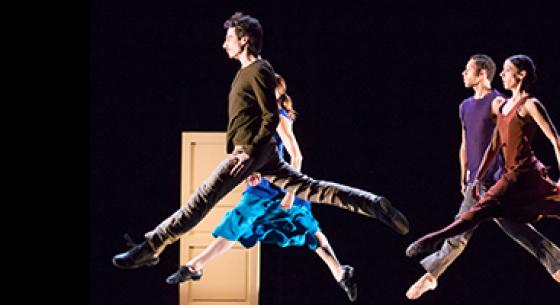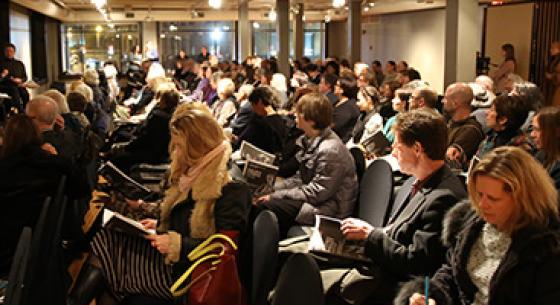Behind the Scenes: World Premiere of Fluence
Editor's Note: On this Sat, Sep 21, Hubbard Street Dance Chicago will present the world premiere of Fluence, choreographed by Robyn Mineko Williams, marking her third premiere set on the company. Williams is a dancer and choreographer based out of Chicago, IL with a dense performance and choreographic history.
We sent Williams a few questions to give you a sneak peek into her process, history, and approach to choreography. Find out more yourself at the Performance Preview prior to Sat’s show, where Emilie Plauché Flink will lead a public conversation with Williams, as well as Hubbard Street Artistic Director Glenn Edgerton and choreographer Alejandro Cerrudo. Catch this Performance Preview at the State Theatre this Sat, 6:45 pm.
Your first choreographed piece for Hubbard Street was made in 2001, as part of its Inside/Out Choreographic Workshop. How did that experience shape your work as a choreographer? What importance does that type of program hold for launching choreographic careers?
Robyn Mineko Wiliams: I’d never even thought about choreographing, before Inside/Out. It was an opportunity to explore and experiment with choreography and offered a safe atmosphere to create, for artists who may feel intimidated in some way by choreography, or think, “It’s not really up my alley,” which was really important for me. I would’ve never even attempted choreography had it not been for Inside/Out. That very first piece was actually a sort of video installation, half-choreographed and half improvisation, at the Arts Club [of Chicago]. It was a project with students from Lawndale [Community Academy], a school [fellow Hubbard Street dancer] Jay Franke had been working with, who gave me the reference. We went in there and interviewed them, and made up a dance from their words and from having them show us their moves. It was a more interactive project. I think I called it What’s the Crybaby? because one of the kids from Lawndale taught us how to do a dance called “the Crybaby.” [Laughs]
Does the fact that you know Hubbard Street dancers extremely well influence the choreography and creation of your pieces? RMW: Knowing the dancers, knowing their personalities, is key to the way I like to work because I pull from people’s unique quirks or affectations or…what’s the word… Mannerisms. Personal movement traits. That allows something human to come into the piece, to make it relatable for an audience, I think.
Do you amplify or exaggerate these mannerisms for the choreography, like caricature?
RMW: Sometimes I exaggerate them or modify them in some way, but actually oftentimes I try to make them more subtle. It depends on what the quirk is to begin with, and what we’re trying to achieve with the piece.
Does this method ever make your dancers aware for the first time of the habits they have?
RMW: Oh, yeah—sometimes they have no idea until I point it out and, also, I will pull from things I do, too. In [process for 2012 work] Recall, [former Hubbard Street dancer] Pablo Piantino noticed that I always pull on my lower lip when I’m thinking, which is something I’d never been aware of. He called me out!
So the source doesn’t necessarily have to be a movement mannerism in a dance context. It can be a tick that someone has just in “real life,” like in social situations?
RMW: Exactly. I actually find those things to be almost more interesting than people’s dance habits. From the program’s description, the choreography in Fluence suggests technological glitches that fluctuate between human versus avatar-like controlled movement. What does this relationship say about today’s technology-consuming culture?
RMW: I think that kind of movement in my work comes from my fascinations with time and with memory—the “speeding up” or “slowing down” of time that we experience every day, or the ways we “fast-forward” or “rewind” certain experiences, either in the moment or as we “replay” our memories of them. It’s also for me in the way that memories can interject themselves into the present, in jarring ways. As in film, for example? Like a flashback image in the middle of a scene?
RMW: Yeah, yeah. Like that. And I just think about time and memory a lot, which plays into how I choreograph in a “patchwork” kind of way, taking bits from different phrases and mashing them together. Which also helps me discover new ways to move. If I’m improvising, it’s all connected and I’m pretty much going to move in natural, organic ways. Collaging phrases together helps me tweak that path, so I’m not just repeating myself.
So, to jump back, what role does everyday technology play in that process? Remembering 2001, for example, when you made your first piece: I would imagine there’s much more technology in your life and routines today. RMW: Sometimes, I feel like technology is very helpful, to me and my poor memory. [Laughs] It’s easier to document things, to record something and keep it right there in front of you, or to go back and search for something specific. But sometimes the speeding-up that comes with that… I don’t like it. It can overwhelm me. Things can happen too quickly now, as a result of technology. You’ve said that one of the last steps in your choreographic process is often heavy editing—going back through what you’ve finished and taking things out, like a sculptor. Is that related? Is the editing process a way to “slow down” the work, to a pace that feels more appropriate to your idea?
RMW: Maybe. Yeah. Yes. Stillness is really important to me. I watch my work and can think, “Whoa, there’s a lot happening here,” and then I’ll interject some stillness, just for a moment. I can feel my heart start to race when the balance gets off, and that’s the way I correct it. How do the visual effects in Fluence complement the choreography?
RMW: So, I’m playing with a visual effect at the end of the piece that comes from the throwing of colored powders during Holi, the Hindu festival, this beautiful ritual that [Hubbard Street dancer] Jessica Tong told me about, this just awesome explosion of colors. I found it mesmerizing, and in July, was at a street fair in my neighborhood and discovered a possible way to reference that onstage, to make these little…poofs happen. I hope. I won’t know for sure until we get to Minneapolis, if it’ll work the way I want it to. We’ll see. [Laughs] I don’t want to give any more than that away. Who are the choreographers who have influenced your work the most?
RMW: I’ve pulled a lot from [Finnish choreographer] Jorma Elo, from the way he works in the studio. He always made the process so fun and filled with such trust. I appreciated that so much. During an intense, five-week creative process, it can get tense. There’s a lot of pressure on the dancers and, you know, sometimes a choreographer wants that tension and can find ways to use it for the piece. But in Jorma’s rehearsals, the work ethic was still at the highest level, but the atmosphere was just amazing. I just work best when I’m relaxed and comfortable in my surroundings, and try to make that for the people in the room. As far as movement goes, I feel like every choreographer I’ve ever worked with, every piece I’ve learned — they’re all a part of me in some way. It’s just this huge, crazy stew of experiences. So instead, I just like to remember things that I enjoyed about a process, things I didn’t enjoy about a process, and take those into account when I’m at the front of the room. I’m not so far away from being a dancer yet. I hope I don’t forget those things.
*Pictured above: Rehearsal for Fluence by Robyn Mineko Williams with the choreographer, left, Rehearsal Director Lucas Crandall, and Hubbard Street Dancer Meredith Dincolo (background in mirror). Photo by Todd Rosenberg.

